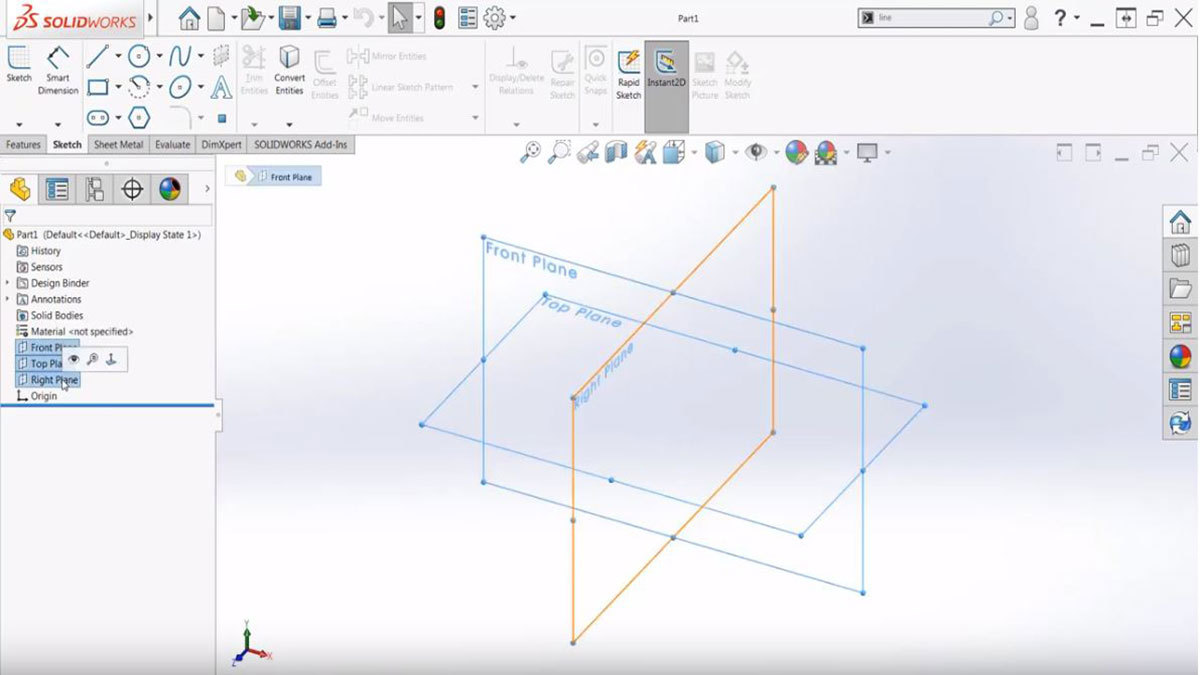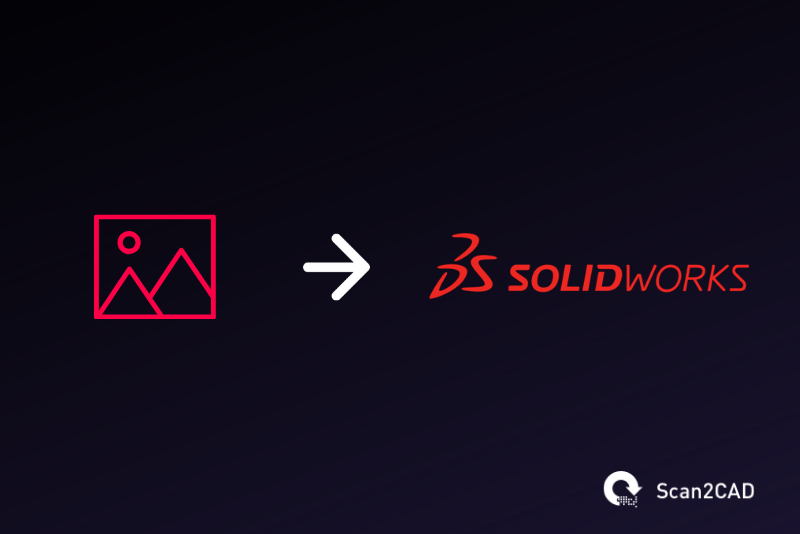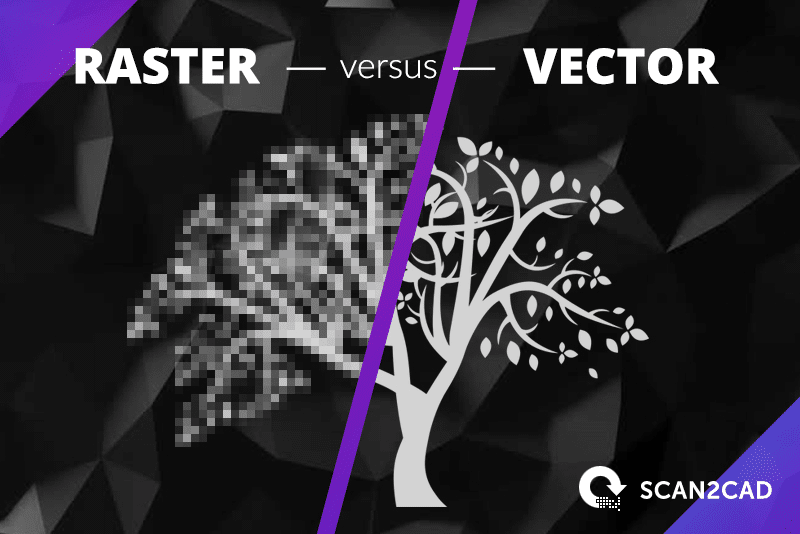convert pdf drawing to 3d model
Convert PDF to 3D SolidWorks Model
![]()
About SolidWorks
SolidWorks is a powerful 2nd and 3D CAD programme that has seen extensive apply with digital drafters all effectually the globe. In 2016, Dassault Systèmes reported 2.3 million agile users in more than 230,000 companies and 80 different countries and that number has just connected to grow.
A lot of its popularity comes from its intuitively easy interface and program workflow. It employs a " tiptop-down " arroyo in design – the user starts with a 2D sketch oriented on a starting plane and then proceeds to sculpt a 3D model out of the initial 2D geometry. The programme's list of 2D and 3D sketch tools is extensive, with CAD standards such as lines, splines, arcs, and circles and all the typical 3D modeling tools every bit well.
Thinking and designing in second offset earlier working on the 3D model helps drafters think about precise measurements and proportions more easily and more thoroughly. Ideally, users volition have editable CAD files to work with when converting 2d into 3D but most drafters will empathise the frustration of how, at times, all y'all have to work with every bit reference are client-sent PDF files.
PDF files are created for the meaty sharing of documents and drawings. It's a file format that mostly only Adobe programs tin can readily edit. As such, PDF files are non easily editable in-program within SolidWorks and that difficulty only gets worse when you consider how a lot of PDF files contain raster images rather than vector data. And so what are our options and how exercise we keep?
Permit'southward have a wait at how PDF to 3D SolidWorks model processes work and what our best form of action tin can exist.

The basic SolidWorks piece of work interface Source
On importing images
SolidWorks can handle importing most of the common epitome file formats as follows:
| 2d Paths | – AI (Adobe Illustrator) – DWG (Drawing) – DXF (Cartoon Interchange/Exchange Format) |
| 3D Mesh | – STL – WRL (VRML) |
| 3D Solids | – .x_t (Parasolid) – IGS, IGES – Sat (ACIS) – STP, Footstep |
| CAD and Vector | – ASM (Pro/E Assembly) – ASM (Solid Edge Associates) – IAM ( Inventor Assembly) – IPT (Inventor Role) – PRT (Pro/E Function) – PRT (Unigraphics) – PRT, CKD (CADKey) – PSM (Solid Edge Part) |
| Sketch Film | – BMP (Bitmap) – GIF (Graphic Interchange Format) – JPG, JPEG (Joint Photographic Experts Group) – PNG (Portable Network Graphics) – PSD (Adobe Photoshop Certificate) – TIF, TIFF (Tagged Prototype File Format) – WMF (Windows Metafile) |
| Special Files | – CATIA Graphics – IDF, EMN, BRD – IFC – Indicate Cloud Files – Rhino Files – VDA (VDAFS) |
Equally extensive as the listing may be, PDF is non one of the native file types that SolidWorks tin handle. At that place are, however, some workarounds which nosotros'll get into presently.
Clarity is the number i factor in considering reference images to use. This determines how accurate our final product will be and how easily we are able to attain our end goals. A 3D model made from pixelated, askew, poorly-scaled 2D reference files will most certainly be subpar for most professional settings. And so the first step is making sure we take the all-time possible starting point with the all-time possible version of the reference prototype.
Once yous have a clear paradigm, the most straight-forward style of converting it into editable SolidWorks elements is to but trace over information technology. For simpler images, SolidWorks even has an automatic tracing part that aims to trace over the sold lines of the paradigm. Do notation that this may non be the well-nigh ideal solution since the automatic tracing leaves some to be desired when information technology comes to make clean, accurate output. Then if you do want to use Solidworks' automatic tracing, keep in heed that it's only suitable for unproblematic line images with plenty of room for inaccuracies.
-

-
Yous MIGHT ALSO Like:
How To Trace An Prototype In SolidWorks
With more circuitous technical drawings, users will typically use Solidworks' 2D CAD tools to trace over the lines in the image, similar to how manual drafters would replicate drawings by using tracing paper and manual drafting tools.
Although this method is accurate and is limited merely by the user's comprehension of the original paradigm, it is not the fastest method and certainly not the easiest to practice. Luckily, there are various third-political party programs such as Scan2CAD that specialize in raster-to-vector conversion and tin can do so with much better results that any CAD plan's automatic tracing functions. These programs can convert your raster PDF's into readily editable vector files that you can plop into SolidWorks and work with without having to do a lick of digital trace-over.
Raster vs. Vector
We've been covering a lot of ground on how importing images into SolidWorks works and so far and a lot has been mentioned about raster and vector images. Let's have a quick refresher on what the differences between the two image types are.
Raster images, also known every bit bitmap images, consist of clustered colored pixels that course a coherent image. Most of the more well-known image file types are raster formats such as .jpeg, .png, and even .gif. Raster images are static, uneditable image types with quality that depends on the file size and number of pixels in the image.
Vector images, on the other hand, are made of formulas and information that are then digitally converted into images. A vector image of an arc, for instance, is actually a file containing information that dictates the arc'due south radius, line length, color, thickness, etc. Editability is this file type'southward strong suit since information technology isn't constrained past pixel number or quality and can exist readily opened and changed past whatever vector-editing program.
-

-
Y'all MIGHT ALSO LIKE:
Explained: Raster versus Vector
PDF files are tricky to piece of work with since they can contain both raster and vector information. Information technology's easy to understand why we would adopt vector PDFs to raster PDFs only what practise nosotros do when the file has both? We'll cover what to exercise in that situation and more in this article.
Converting a PDF using SolidWorks tools
When all is said and done, uploading a PDF image to trace and model in SolidWorks is a straight-frontward and simple process. It might require some workarounds since the program can't natively handle PDF files, but the process every bit a whole is easy to empathise.
- The first thing you'll want to do is go a workable file format out of the PDF yous want to use as a reference image. Both modern Macs and PCs have born screenshot tools you'll desire to take advantage of. Even if your auto doesn't have that, there are plenty of free screen capture programs you lot can download and utilise.
Take a screenshot of the part of the PDF you lot want to utilize as a SolidWorks reference and save it in a file format that the software tin can handle. From this point on, you won't have to worry about the PDF anymore and just use the saved screenshot as your image reference.
- On SolidWorks, figure out the plane you want to be sketching in. If the epitome is a peak-downwardly view, choose the Top plane. If it'due south a sideways view, choose either the Right or Left planes and choose the Forepart plane if information technology'due south a front end view. Click on the plane on the left side of the screen and create a sketch.
- Under the Tool menu, choose Sketch Tools > Sketch Picture show. On the dialog box that pops upwards, browse for your reference image and open up information technology up on your chosen plane.
- Yous'll want to exercise a final resizing and cropping of the reference photograph before you starting time sketching. Information technology's ever best to practice this at the kickoff so you don't accept to go through the problem of correcting your sketch size after.
- From hither on out, it'due south just a matter of tracing over the image with SolidWorks' sketch tools and and so using the corresponding trace to create a 3D model. It's a simple procedure but becomes a tedious task if the reference image in question is large enough or complex enough equally a reference drawing.
Converting a PDF to SolidWorks
If you lot always notice yourself in need of a conversion program for PDF files, a quick Google search volition net you with pages upon pages of results for online conversion tools. With almost all of these results, the quality of the output you're getting is merely downright subpar. If you're lucky enough to observe one that produces something decent, yous'll probably exist dealing with watermarks or partial conversions. Another issue to consider is the sheer amount of privacy risks yous're taking with uploading or emailing your PDF documents for conversion.
If y'all're dealing with a depression-chance, old conversion, this might be good enough for you. But for annihilation more, your best choice would accept to exist specialized desktop programs such equally Scan2CAD.
Step ane: Catechumen the PDF
Programs like Scan2CAD will ordinarily require a purchase or subscription, but if yous're dealing with repeated PDF conversions for piece of work, the program will eventually pay for itself. Scan2CAD specifically even has a 14-mean solar day free trial period for you to try and see if the program is worth the payment. There simply isn't a better solution if you're looking for a reliable, consequent, quality conversion program.
So allow's accept a await at the footstep-by-step procedure of using Scan2CAD to catechumen your PDFs into usable file formats for SolidWorks.
- Open upwardly the reference PDF file you want to use on Scan2CAD. A dialog box will open that will brandish both the raster and vector elements in the document. Unfortunately, if the document has both elements and you need both the raster and vector elements equally references, yous'll have to convert and salve both individually.
- For raster data: Using the Clean epitome option, turn the raster image monochromatic and clean information technology upward until you're satisfied. Proceed to catechumen the raster paradigm into vector data and save it as a usable vector file that you can then edit on SolidWorks.
For vector data: Merely open upwardly the vector information and then salvage information technology equally a workable file type.
We take plenty of data on these processes in the form of tutorials and articles if you want to acquire more than about how to utilize Scan2CAD.
Pace ii: Import into Solidworks
- Open up the now workable vector file and utilise that as an editable reference on SolidWorks.
Here'southward a quick video to detail that procedure:
Source: https://www.scan2cad.com/blog/cad/pdf-dwg-solidworks-model/
0 Response to "convert pdf drawing to 3d model"
Enviar um comentário